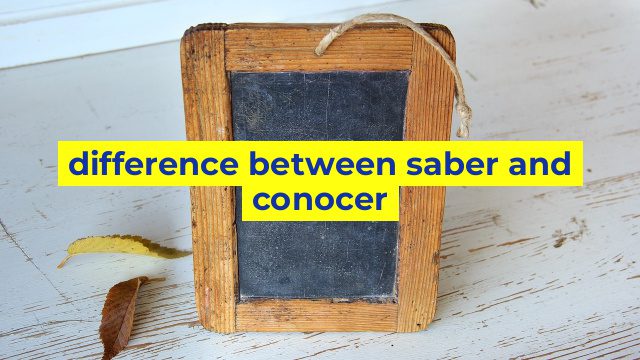The Difference Between Saber and Conocer
In Spanish, there are two verbs that are commonly used to express knowledge or familiarity with people, places, things, or ideas. These verbs are “saber” and “conocer”. Although they are often translated to “know” in English, they have different meanings and uses.
Saber
“Saber” is used when referring to knowledge or information that you have learned or memorized such as facts, skills, or how to do something. This verb is usually followed by a specific piece of information or a clause that describes the action or object that is known.
For example:
– Yo sé hablar español (I know how to speak Spanish)
– Tú sabes la respuesta (You know the answer)
– Él sabe tocar la guitarra (He knows how to play the guitar)
Conocer
“Conocer” is used when referring to familiarity or acquaintance with people, places or things. This verb is usually followed by a direct object which can be a person, a place, or a thing.
For example:
– Yo conozco a Maria (I know Maria)
– Tú conoces la ciudad de Barcelona (You know the city of Barcelona)
– Él conoce bien el tema de la educación (He is familiar with the topic of education)
When to use saber and conocer?
It is important to understand the difference between saber and conocer in order to use them correctly. The following examples illustrate how to choose the correct verb:
– Saber: to know facts, skills or how to do something. Example: Yo sé cocinar (I know how to cook).
– Conocer: to be familiar with people, places or things. Example: Yo conozco a mi vecino (I know my neighbor).
In some cases, either verb can be used depending on the context:
– Yo sé la ciudad de Madrid (I know the city of Madrid) – means you have visited the city or researched about it, so you have knowledge about it.
– Yo conozco la ciudad de Madrid (I am familiar with the city of Madrid) – means you have lived or spent considerable time in the city, so you are familiar with its streets, landmarks, and culture.
In conclusion, saber and conocer are two very important verbs in Spanish that are used to express different types of knowledge and familiarity. Understanding their meanings and uses will help you communicate more effectively in Spanish, and avoid common mistakes while speaking or writing.
Table difference between saber and conocer
| Feature | Saber | Conocer |
|---|---|---|
| Definition | To know information, facts, or how to do something | To be familiar with a person, place, or thing |
| Used with | Things, information, skills | People, places, things |
| Examples | I know how to speak Spanish. | I know Maria from work. |
| Past tense | Supe | Conocí |
| Present participle | sabiendo | conociendo |


